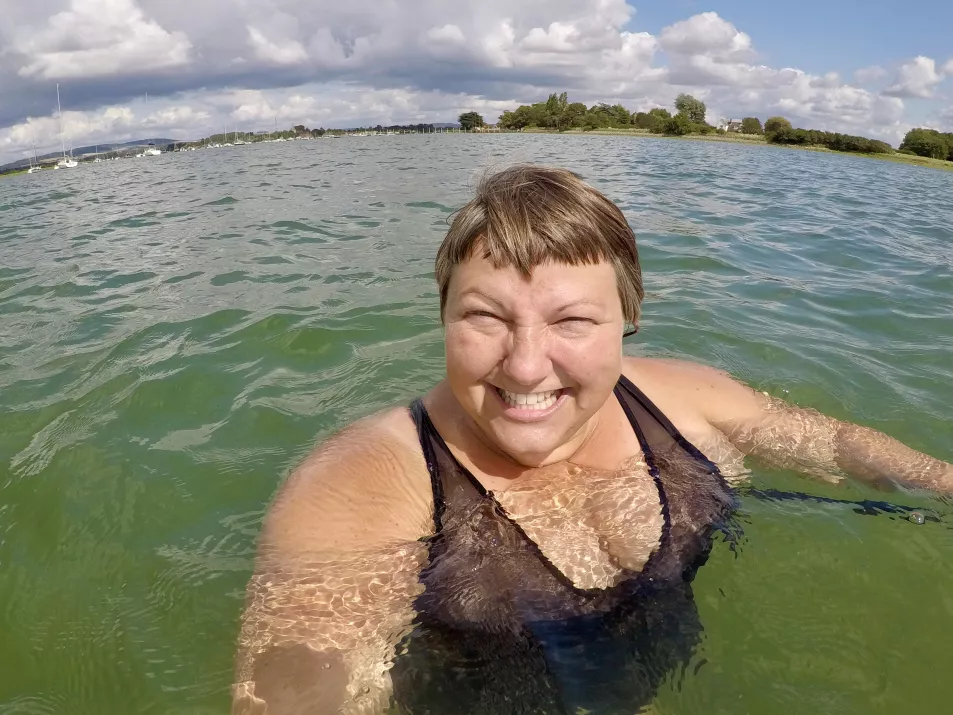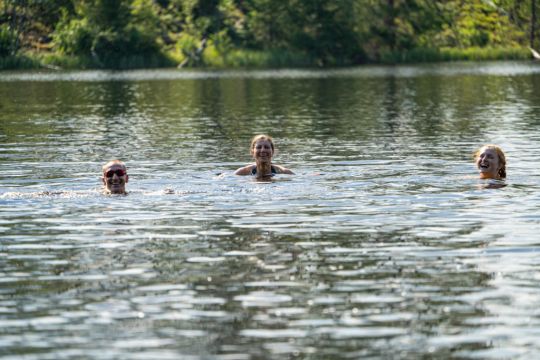More and more of us are cottoning on to the joys of outdoor swimming. Whether you want to be closer to nature, inject a bit of adventure into your life, or chase that mood-boosting buzz – the appeal of a wild (or semi-wild) dip is endless.
But, it’s definitely a good idea to ask questions before giving it a go. There are safety factors to consider – like not swimming alone and being aware of cold water risks – and you’ll want to choose a suitable location.
Curious? We ask seasoned outdoor swimmers to answer some pressing questions…
I’ve never really been the sporty type. Will I fit in and feel welcome?
“Yes! I swim with people of all ages and abilities – many started because of lockdown when pools were shut. That’s how I got into it,” says PR coach Amanda FitzGerald (amandapr.com). “Some people do the head-out-of-water breaststroke and chat/have laugh kind of swim, and others do the serious head down, let’s put in some mileage swim.”
Journalist, open water lifeguard and swim coach Ella Foote, aka ‘The Dip Advisor’ (thedipadvisor.co.uk), agrees. “The outdoor swimming community is so welcoming. Swim fitness isn’t something you can see – all body types swim and for different reasons,” Foote says.

“Once in the water, we all look the same. So long as you can swim and keep aware of your limits, you can enjoy the water. There are plenty of groups across the country that welcome all, so you never have to swim alone. With Dip Advisor, it’s all about swimming at a leisurely pace and enjoying the wild spaces.”
Can you do it at any age?
Obviously, with young children, safety is even more paramount. “Children love the adventure of an outdoor dip – but be aware they get colder quicker and very young children can swallow more water than older children, so it can be a risk in wild water,” says Foote. “Never take your eyes off them and be in the water with them.”
Being a bit older needn’t stop you – providing you can swim. “Many swim well into their 80s and 90s,” Foote adds. “Swimming is low impact on joints and great for gentle exercise.”

FitzGerald was gifted a wetsuit for her 50th birthday in 2020. “Probably one of the best gifts ever, as it opened up a whole new world,” she says. “I have a wonderful bunch of swim BFFs who I go on weekly river, lido or sea swims with.” She even recently completed a 4k endurance swim for charity (donate.giveasyoulive.com/fundraising/4k-endurance-swim-challenge).
Do you need to live near the sea or countryside?
“The great thing about open water or wild swimming is that you don’t need to live near the coast or in the countryside to access it,” says fitness blogger Michael Adeniran, aka ‘The Urban Challenger’ (@theurbanchallenger).
“I fell in love with open water swimming after being introduced to a couple of venues in London. I was approached to take on my first triathlon and I knew pool swimming wasn’t going to be enough, as open water is completely different. After a few sessions, I fell in love, and since then have continued.”
What is cold water shock?
Cold water coach Fenwick Ridley, who runs H2O Trails in Northumberland (h2otrails.co.uk), explains there are additional safety considerations when it comes to cold water (defined as anything below 15°C). Cold water shock is essentially the body’s natural “protective response”, when blood is drawn rapidly away from the skin’s surface.
It’s a key reason why submerging too quickly can be extremely dangerous, as it can cause rapid breathing and blood pressure to spike. “One of the first things people notice with the shock response is the gasp reflex – that intake of air we generally get when we reach the waistline,” says Ridley.
“The way we manage it is through acclimatisation – a step by step process every time we get in. That’s basically getting the water onto our skin, walking in slowly, and taking time to get our breathing right. A neat trick is, as we enter the water, we go down to our shoulders on an exhale. Blowing out as we go down, slowly.”
This is also why getting into icy water is different than going for a swim in a mild lake or lido. You never want to push yourself to stay in too long – a cold-water dip might just be one or two minutes max.
Can you swim anywhere or only in designated spots?
Ridley says there are a number of things to consider here. Is it somewhere you’re allowed to swim? And is it safe?
“We’re quite lucky here with options,” he says – although not all bodies of water are safe. “For example, some reservoirs have dangers with filtration and extraction pipes and flood gates.” Even a calm-looking sea or river may have strong currents, depth and temperature changes. Some might contain harmful bacteria too.
“There are lots of swimming venues now, and a lot more groups out there who would be willing to show you where they swim,” adds Ridley.
The thought of mud, reeds and creatures in lakes and rivers freaks me out – any tips?
“Some people I swim with also hate the idea of ‘what lies beneath’ so they just don’t put their heads under. I personally love seeing the forest of water plants – it’s another world, and sometimes you’re gifted by seeing some fish,” says FitzGerald. “But to avoid this, you can wear a wetsuit and swim socks and gloves, so you won’t feel anything.”
What’s the best way to warm up afterwards?
“Even in summer, you can feel cold after a dip,” says Foote. “The best and most efficient way to warm up is to dry off, remove any wet clothing/material and put on dry layers. If it’s a cold month or there’s a breeze, a thermal base layer, with a good jumper and decent jacket/coat, depending on the season, is best. A hot drink will warm you from the inside.”
Ridley is fond of a sugary tea or hot chocolate. “Also, jumping into a hot shower straight after a super cold swim can make you faint,” he adds. Instead, focus on getting into your dry warm layers.
Why do some people wear wetsuits and others don’t?
This is often personal preference, although some venues have rules, depending on time of year and temperature.
“Wetsuits provide warmth and buoyancy. They can protect you from the sun and help with natural sensations like swimming among reeds,” says Foote. “I prefer swimming without, as I love all the sensory experiences of being in outdoor water. The best thing to wear is the thing that makes you feel most comfortable and enables you to enjoy the swim.” There’s also the option of neoprene gloves and boots, if you just fancy a bit of coverage on those bits.







